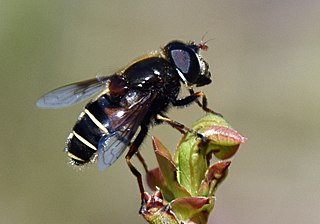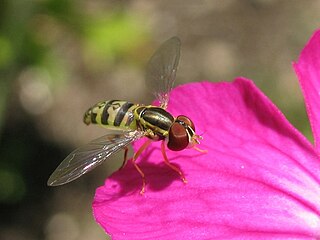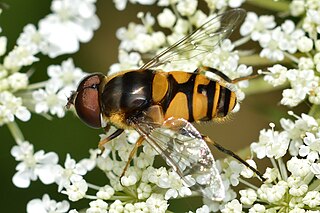
Platycheirus clypeatus is a species of hoverfly. It is found across the Palearctic and in the Nearctic. The larvae feed on aphids. Adults are usually found on the edges of woodland or scrub, heath or along hedgerows where they visit a wide range of flowers.

Toxomerus marginatus, also known as the margined calligrapher fly, is a common species of hoverfly. It is found in many parts of North America.

Platycheirus granditarsus, the Hornhand Sedgesitter, is a species of hoverfly. It is found in many parts of Britain North America and Europe. Typical habitat includes marshy meadows and ditches, where it can be found between May and October, though it is at its commonest between July and September. The most distinctive feature of this fly is the red-orange abdomen most easily seen as it takes off or alights.

Eristalis cryptarum is a holarctic species of hoverfly. Known as the bog hoverfly or bog-dwelling drone fly, it is a bog specialist but may occur in other wetlands. Its larvae are assumed to live in peat that is saturated with water, such as that found in these boggy areas. The female has been observed depositing eggs on and close to very fresh cow dung along oligotrophic seepages in moorland.

Platycheirus angustatus is a species of hoverfly. It is found in many parts of the Palearctic, and in the Nearctic.

Platycheirus discimanus, the Yellowfoot Sedgesitter is a small species of hoverfly. It is found across Europe and the Palearctic and in North America.

Platycheirus immarginatus, the Comb-legged Sedgesitter, is a common species of hoverfly. It is found in parts of northern Europe and northern North America.

Toxomerus geminatus (Say,1823) the Eastern Calligrapher, is a common species of syrphid fly observed in the eastern and central United States and Canada.(see map) Syrphid flies are also known as Hover Flies or Flower Flies because the adults are frequently found hovering around flowers from which they feed on nectar and pollen. Adults are 6.1–7.6 mm (0.24–0.30 in) long. The larvae are predators of a variety of aphids and mites.

Eristalis transversa, the transverse banded drone fly, is a common species of syrphid fly first officially described by Wiedemann in 1830. Hoverflies get their names from the ability to remain nearly motionless while in flight. The adults are also known as flower flies for they are commonly found around and on flowers, from which they get both energy-giving nectar and protein-rich pollen. The larvae are rat-tailed type but larvae of this specific species has not been reported.

Helophilus lapponicus, the Yellow-margined Marsh Fly, is a common species of syrphid fly observed across northern North America, northern Europe, Greenland and Siberia. Hoverflies can remain nearly motionless in flight. The adults are also known as flower flies for they are commonly found on flowers, from which they get both energy-giving nectar and protein-rich pollen. Though common the larvae of this species are not known but the larvae of other species in this genus are associated with wet decaying organic material, particularly accumulations of decaying vegetation in ponds and mud and are a so called rat-tailed type.

Arctosyrphus willingii, the northern longbeak, is a species of rat-tail maggot fly in the family Syrphidae. This species was formerly a member of the genus Lejops.

Platycheirus coerulescens, the Hooked Sedgesitter, is an uncommon species of syrphid fly in the family Syrphidae. It occurs throughout northern and western Canada and Alaska, south to California and Mexico at high altitudes

Helophilus obscurus , the obscure marsh fly, is a common species of syrphid fly observed throughout Canada and the northern United States and Rocky Mountains. Hoverflies can remain nearly motionless in flight. The adults are also known as flower flies for they are commonly found on flowers, from which they get both energy-giving nectar and protein-rich pollen. The larvae of this genus are associated with wet decaying organic material, particularly accumulations of decaying vegetation in ponds and mud and farmyard manure or silage the larvae of this species are not known.

Platycheirus aeratus, commonly known as Coquillett's sedgesitter, is a species of hoverfly.
Neoascia globosa , the Black-margined Fen , is a fairly common species of syrphid fly observed in northeastern North America. Hoverflies can remain nearly motionless in flight. The adults are also known as flower flies, for they are commonly found on flowers from which they get both energy-giving nectar and protein-rich pollen. The larvae are aquatic.

Platycheirus brunnifrons, sometimes known as the copperhead sedgesitter, is a hoverfly found in high-altitude localities in Finland, Austria, France, Switzerland, Spain, Macedonia, Northeast Russia, and Alaska. It's larvae have not been identified. Adults feed on pollen and nectar primarily Salix sp.

Platycheirus clausseni Claussen's Sedgesitter is a fly in the family Syrphidae or hoverfly. It is distributed throughout the Alps, the Altai mountains in Siberia, and Colorado, United States.

Platycheirus flabella, the smallspot sedgesitter, is a rare species of fly in the family Syrphidae. Found from mountainous regions of Alaska, Yukon Territory, British Columbia, Idaho, Washington, Ontario and Quebec, and Maine. P.flabella is similar to Platycheirus discimanus and Platycheirus thylax

Platycheirus groenlandicus the Arctic Sedgesitter is an uncommon species in the hoverfly family. Range: Subarctic (Alaska, Western USA northern and western Canada, arctic and alpine Greenland, in mountains and in northern parts of Fennoscandia, northern Russia It's small black hoverfly with silver abdominal spots and basal tarsomeres of the front legs are yellow and strongly flattened. Groenlandicus is similar to Platycheirus flabella which has a narrower front basitarsus.

Platycheirus hesperius, the southern punctate sedgesitter, is a fly in the Syrphidae family. It is a rare species found in the USA from Washington south to southern California. Adult Syrphids are also known as flower flies for they are commonly found on flowers, from which they get nectar and pollen. They are also called hoverflies for the ability to often remain nearly motionless in flight.

























